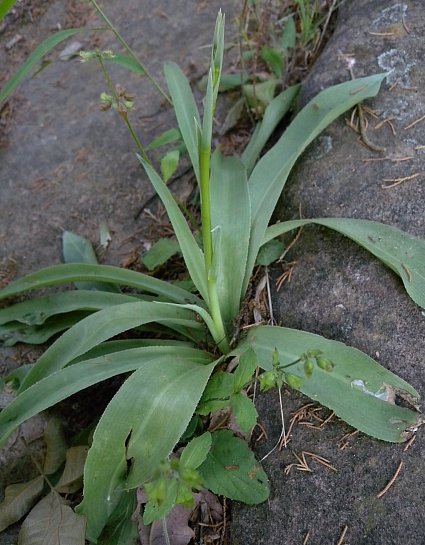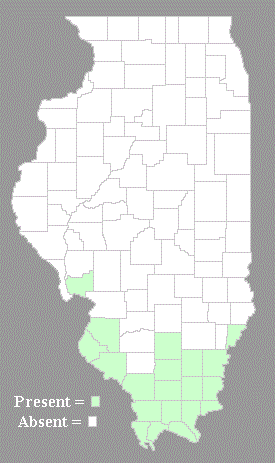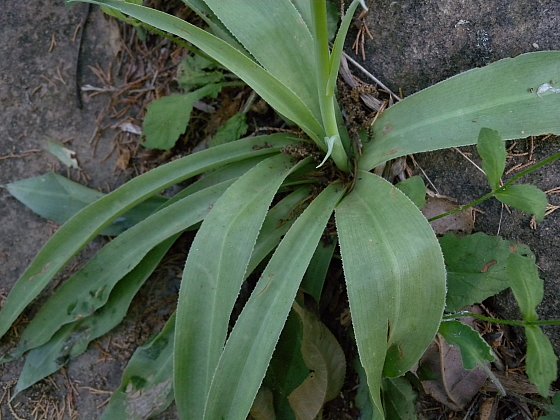
Each flower is ¾-1¼" long, approximately tubular in shape, whitish green or yellowish green, and ascending to erect. Each flower has a tubular corolla with 6 convex ridges, 6 narrowly triangular lobes that are held erect, 6 strongly exerted stamens, and an inferior ovary with exerted style. The tubular body of the corolla is about 2-3 times as long as its lobes; they are both pale green and glabrous. The filaments of the stamens are golden yellow; the long slender anthers are white, becoming brown and deciduous with age. The style is also golden yellow, except for its 3-lobed stigma, which is white. At the base of each flower, there is a membranous-leafy bract up to ½" long. The flowers are mostly sessile,
 although a few lower flowers may have very short pedicels. The blooming
period occurs from early- to mid-summer. The flowers have a slight to
moderate
fragrance that is sweet and fruity. Afterwards, the flowers are
replaced by 3-celled seed capsules that become about ½" long at
maturity. These capsules are globoid-ovoid in shape and angular. Within
each cell of a capsule, there are 2 rows of flattened seeds. Mature
seeds are black and half-orbicular in shape; they can be blown about by
the wind. The root system consists of a bulbous caudex with fibrous
roots below.
although a few lower flowers may have very short pedicels. The blooming
period occurs from early- to mid-summer. The flowers have a slight to
moderate
fragrance that is sweet and fruity. Afterwards, the flowers are
replaced by 3-celled seed capsules that become about ½" long at
maturity. These capsules are globoid-ovoid in shape and angular. Within
each cell of a capsule, there are 2 rows of flattened seeds. Mature
seeds are black and half-orbicular in shape; they can be blown about by
the wind. The root system consists of a bulbous caudex with fibrous
roots below.Cultivation: The preference is partial to full sun, dry-mesic to dry conditions, and either thin rocky soil or sandy soil where there is reduced competition from other ground vegetation. Eastern Agave (Manfreda virginica) can be cultivated as an ornamental plant in the back of a rock garden. While the flowers are not particularly showy, the basal leaves are attractive. Because Eastern Agave has a Crassula acid metabolism (CAM), like cacti and other desert plants, it is very drought tolerant.
Range & Habitat: The native Eastern Agave (Manfreda virginica) is occasional in southern Illinois, while in the rest of the state it is absent. Illinois lies along the northern range-limit of this species. Habitats include rocky openings in upland woodlands, rocky ledges and cliffs along rivers or streams, thinly wooded rocky slopes, upland savannas, and rocky glades (including chert, sandstone, and limestone). Outside of Illinois, this species has also been found in sandy habitats. It occurs in higher quality natural areas.
Faunal Associations: The flowers are cross-pollinated by Sphinx moths, Noctuid moths, and bumblebees (Groman & Pellmyr, 1999). Generally, the moths have been found to be more important pollinators than the bumblebees. These visitors suck nectar from the flowers; some of the bumblebees also collect pollen for their larvae. Aside from its pollination ecology, little is known about the floral-faunal relationships for this species.
Photographic Location: A thinly wooded rocky slope in southern Illinois.

Comments: This is the only member of the Agave family that is native to, or has naturalized in, Illinois. The distinctive Agave-like leaves and the tall spike of greenish flowers makes this species easy to identify when it is encountered in the wild. Unlike true Agaves (Agave spp.), the Eastern Agave (Manfreda virginica) can bloom multiple times during its lifespan. In contrast, the true Agaves bloom only once at the end of their lifespans after a period of several years (or even decades). The latter can be found in the desert SW and Florida of the United States, in Mexico, and other countries further to the south. Other scientific names of Eastern Agave are Polianthes virginica and Agave virginica. Other common names for this species are Virginia Agave and False Aloe. Sometimes Eastern Agave is assigned to the Lily family (Liliaceae) when the Agave family (Agavaceae) is reclassified as a subfamily of the former family.